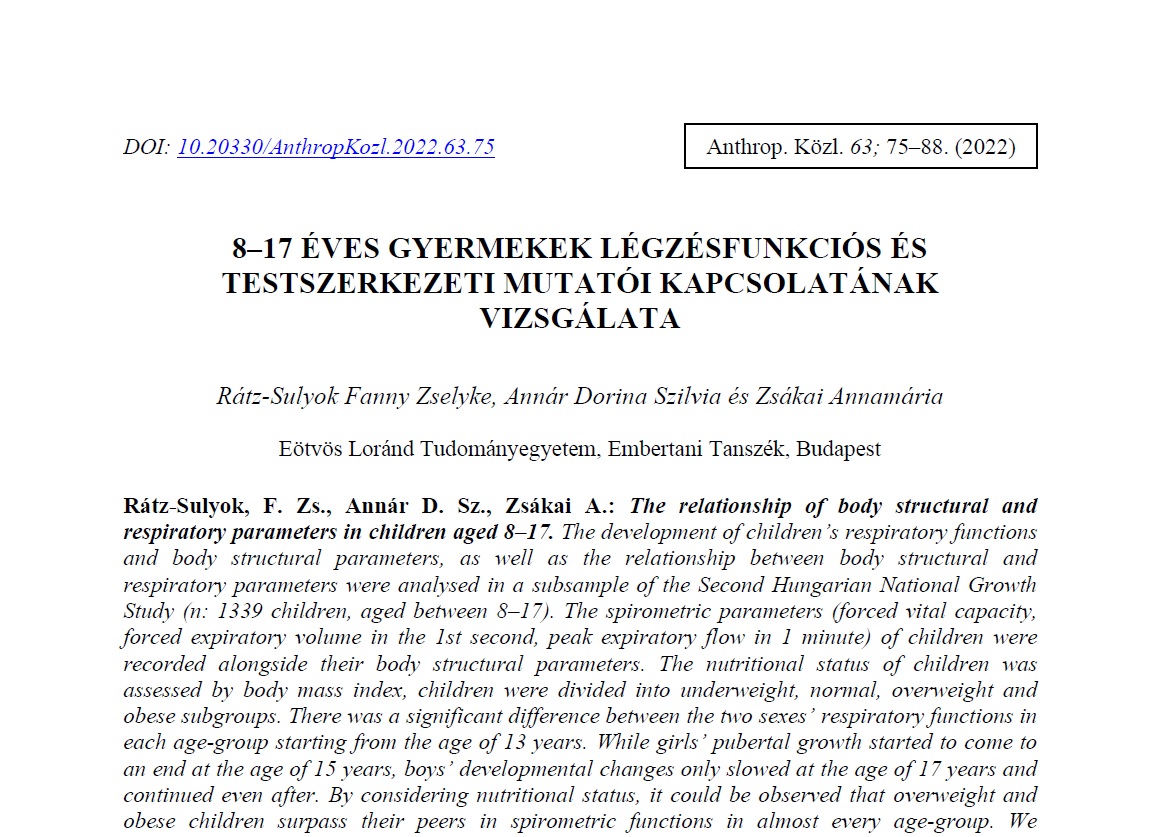8–17 éves gyermekek légzésfunkciós és testszerkezeti mutatói kapcsolatának vizsgálata
Absztrakt
The development of children’s respiratory functions and body structural parameters, as well as the relationship between body structural and respiratory parameters were analysed in a subsample of the Second Hungarian National Growth Study (n: 1339 children, aged between 8–17). The spirometric parameters (forced vital capacity, forced expiratory volume in the 1st second, peak expiratory flow in 1 minute) of children were recorded alongside their body structural parameters. The nutritional status of children was assessed by body mass index, children were divided into underweight, normal, overweight and obese subgroups. There was a significant difference between the two sexes’ respiratory functions in each age-group starting from the age of 13 years. While girls’ pubertal growth started to come to an end at the age of 15 years, boys’ developmental changes only slowed at the age of 17 years and continued even after. By considering nutritional status, it could be observed that overweight and obese children surpass their peers in spirometric functions in almost every age-group. We recommend the use of references of body weight-related spirometric parameters for paediatric use in overweight and obese children, such references of the three studied spirometric parameters are constructed on the basis of the studied sample of Hungarian children. The children scoring below the 5th centile should be considered for further respiratory examinations.
Hivatkozások
Bodzsár, É., Zsákai, A. (2012): Body developmental status of Hungarian children and adolescents, Hungarian National Growth Study 2003–2006. Plantin Press, Budapest. http://antropologia.elte.hu/onv_e.html. pp. 240.
Chhabra, S.K., Vijayan, V.K., Rahman, M., Mittal, V., Singh, P.D. (2012): Regression equations for spirometry in children aged 6 to 17 years in Delhi region. Indian Journal of Chest Diseases and Allied Sciences, 54: 59–63.
Cole, T.J., Bellizzi, M.C., Flegal, K.M., Dietz, W.H. (2000): Establishing a standard definition for child overweightand obesity worldwide: international survey. British Medical Journal, 320: 1–6. DOI: https://doi.org/10.1136/bmj.320.7244.1240
Cole, T.J., Flegal, K.M., Nicholls, D., Jackson, A.A. (2007): Body mass index cut offs to define thinness in children and adolescents: International survey. British Medical Journal, 335: 194–197. DOI: https://doi.org/10.1136/bmj.39238.399444.55
Graham, B.L., Steenbruggen, I., Barjaktarevic, I.Z., Cooper, B.G., Hall, G.L., Hallstrand, T.S., Kaminsky, D.A., McCarthy, K., McCormack, M.C., Miller, M.R., Oropez, C.E., Rosenfeld, M., Stanojevic, S., Swanney, M.P., Thompson, B.R. (2019): Standardization of spirometry 2019 update an official American Thoracic Society and European Respiratory Society technical statement. American Journal of Respiratory and Critical Care Medicine, 200: E70–88. DOI: https://doi.org/10.1164/rccm.201908-1590ST
Jat, K.R. (2013): Spirometry in children. Primary Care Respiratory Journal, 22: 221–229. DOI: https://doi.org/10.4104/pcrj.2013.00042
Kotecha, S.J., Watkins, W.J., Paranjothy, S., Dunstan, F.D., Henderson, A.J., Kotecha, S. (2012): Effect of late preterm birth on longitudinal lung spirometry in school age children and adolescents. Thorax, 67: 54–61. DOI: https://doi.org/10.1136/thoraxjnl-2011-200329
Kouri, A., Dandurand, R.J., Usmani, O.S., Chow, C.W. (2021): Exploring the 175-year history of spirometry and the vital lessons it can teach us today. European Respiratory Review, 30: 210081. DOI: https://doi.org/10.1183/16000617.0081-2021
Levy, M.L., Quanjer, P.H., Booker, R., Cooper, B.G., Holmes, S., Small, I.R. (2009): Diagnostic spirometry in primary care: Proposed standards for general practice compliant with American Thoracic Society and European Respiratory Society recommendations. Primary Care Respiratory Journal, 18: 130–147. DOI: https://doi.org/10.4104/pcrj.2009.00054
Miller, M.R., Hankinson, J., Brusasco, V., Burgos, F., Casaburi, R., Coates, A., Crapo, R., Enright, P., van der Grinten, C.P.M., Gustafsson, P., Jensen, R., Johnson, D.C., MacIntrye, N., McKay, R., Navajas, D., Pedersen, O.F., Pellegrino, R., Viegi, G., Wagner, J. (2005): Standardisation of spirometry. European Respiratory Journal, 26: 319–338. DOI: https://doi.org/10.1183/09031936.05.00034805
Neve, V., Girard, F., Flahault, A., Boulé, M. (2002): Lung and thorax development during adolescence: Relationship with pubertal status. European Respiratory Journal, 20: 1292–1298. DOI: https://doi.org/10.1183/09031936.02.00208102
Quanjer, P.H., Hall, G.L., Stanojevic, S., Cole, T.J., Stocks, J. (2012a): Age- and height-based prediction bias in spirometry reference equations. European Respiratory Journal, 40: 190–197. DOI: https://doi.org/10.1183/09031936.00161011
Quanjer, P.H., Stanojevic, S., Cole, T.J., Baur, X., Hall, G.L., Culver, B.H., Enright, P.L., Hankinson, J.L., Ip, M.S.M., Zheng, J., Stocks, J., Schindler, C. (2012b): Multi-ethnic reference values for spirometry for the 3-95-yr age range: The global lung function 2012 equations. European Respiratory Journal, 40: 1324–1343. DOI: https://doi.org/10.1183/09031936.00080312
Quanjer, P.H., Tammeling, G.J., Cotes, J.E., Pedersen, O.F., Peslin, R., Yernault, J.C. (1993): Lung volumes and forced ventilatory flows. European Respiratory Journal, 6: 5–40. DOI: https://doi.org/10.1183/09041950.005s1693
Weiner, J.S., Lourie, J.A. (1969): Human Biology, A Guide to Field Methods. Blackwell Scientific, Oxford.




